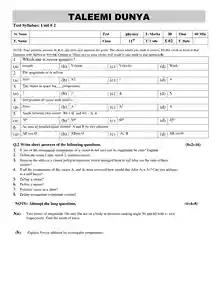phy-11-unit-2
phy-11-unit-2
Vectors and Equilibrium from your 1st-year physics course.
Vectors:
A scalar is a quantity with magnitude only (e.g., temperature, mass).
A vector has both magnitude and direction (e.g., displacement, force).
Vectors are represented in a rectangular coordinate system.
Addition of vectors: Graphically, vectors are added by placing them head-to-tail and connecting the tail of the first vector to the head of the last vector.
Resultant vector: The sum vector of two or more vectors.
Unit vectors: Describe directions in space (magnitude = 1, no units).
Null vector: A vector with zero magnitude and no specific direction.
Position vector: Describes a particle’s location relative to the origin.
Equilibrium:
A body is in equilibrium if it has zero translational and angular acceleration.
Translational equilibrium: Vector sum of all forces acting on the body is zero.
Rotational equilibrium: Sum of torques about any axis is zero.
Vector Components:
Vectors can be broken down into components along different axes (e.g., x, y, z).
The magnitude of a vector can be calculated using its components.
The direction cosines (cosines of angles with coordinate axes) help express vector components.
Equilibrium Conditions:
For translational equilibrium, the net force acting on an object must be zero: ∑F=0.
For rotational equilibrium, the net torque about any axis must be zero: ∑τ=0.
Applications:
Vectors are crucial in fields like engineering, physics, and computer graphics.
Equilibrium concepts are used in structural engineering (e.g., analyzing bridges, buildings) and statics problems.
